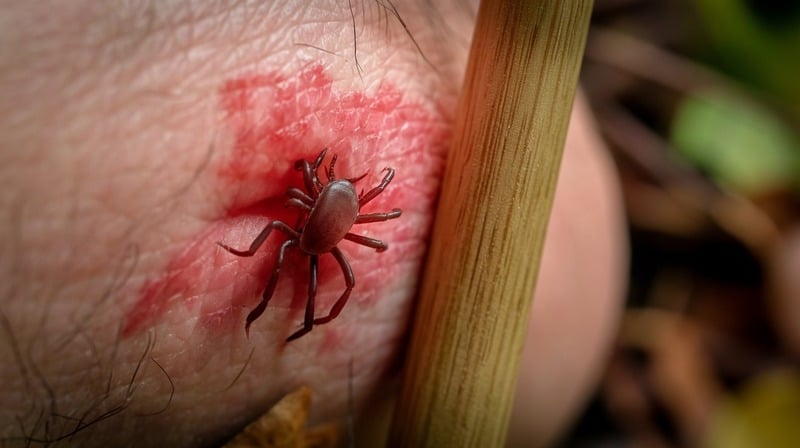
You’re hiking, camping, or just enjoying your backyard, and suddenly-you spot a tick. Panic sets in. Is this a medical emergency? Should you drop everything and race to urgent care? Take a deep breath. Not every tick bite is a disaster waiting to happen.
Most people completely overreact when they find a tick, imagining worst-case scenarios of rare diseases. The truth is, most tick bites are totally manageable, and you don’t need to rush to the hospital every single time.
Table of Contents
ToggleWhat Actually Happens When a Tick Bites You?
Let’s discuss something that people don’t commonly understand-ticks are nearly microscopic vampires with a predilection for humans. When a tick makes its way onto your skin, it’s not merely resting.
These tiny creatures are on a path to consume your blood. Once they attach themselves to you, they lock in and begin to gorge themselves, creating a scene that’s equal parts disgusting and potentially harmful.
The process is quite astonishing. As the tick attaches itself, it employs specialized mouthparts to puncture your skin and begins to suck your blood.
Most people don’t know this: the longer a tick stays put, the greater the chance that it will give you a disease. Ticks, then, are kind of like a time bomb with health consequences that you first detonate in the act of pulling one off and deactivate by not leaving one in the wild to reattach.
Red Flags: When Urgent Care is Actually Necessary
What does this mean for you? Most tick bites are nothing to worry about, but some symptoms you could experience make it imperative that you seek medical attention right away. If you develop the classic bulls-eye rash (the most reliable sign of Lyme disease), you need to go straight to a health professional at Insight Urgent Care. If you run a fever that emerges within a few weeks of the bite, that’s another serious warning sign.
Give your body undivided attention. If you experience intense joint pain or muscle aches in the wake of a close encounter with a tick, these symptoms might result from something more serious than a lightweight insect. Pay close attention to your body.
When a tick burrows into your flesh, you might not feel it at first. Intense joint pain or muscle aches that develop after a close encounter with a tick could indicate that you’re one of the unlucky few who’ve been bitten.
DIY Tick Removal: The Right Way
Removing a tick requires precision and care. You should use a pair of fine-tipped tweezers. The extraction should be done slowly and methodically, with the focus being on removing the entire tick. Do not grab the tick with the tweezers in the middle.
The best place to grab a tick when using tweezers is right where the tick’s head meets its body. Squeeze here only tightly enough to hold the tick; do not squeeze so hard that you might push infected fluids from the tick’s body into your own.
Hold the tweezers near your skin’s surface, then pull up straight and steady. Don’t twist or jerk. If you do, the mouth parts could break off and stay in your skin. After the tick is out, disinfect the bite site to make sure no germs get in. Alcohol is best, but hydrogen peroxide or soap and water will work too.
You May Like: What Travel Vaccines Do I Need Before Going Abroad?
Disease Risk: What You Actually Need to Know
The condition most famously spread by ticks is Lyme disease, but this is far from the only concern. Ticks are little carriers of all sorts of serious maladies, like Rocky Mountain spotted fever and anaplasmosis. The disease threat from a tick depends a lot on where you live-some places have much higher rates of disease transmission than others.
It’s important to remember that ticks are not always carriers of disease, but they always have the potential to be. Because of regional variations, it’s prudent to keep abreast of the specific risks where you live.
Many local health departments provide excellent resources that outline the kinds of tick-borne diseases that are a threat in their communities, as well as the ticks that carry them.
Prevention: Better Than Cure
Your best defense against tick encounters is prevention. When you are in wooded or grassy areas, dress strategically. Long sleeves and long pants help create a physical barrier between your body and these tiny invaders.
DEET-containing bug spray is your ally. Use it cautiously, and apply it to any skin or clothing that could be exposed to a tick. Follow the product’s instructions.
After an outdoor event, look closely for any ticks that might be trying to attach themselves to you. Pay special attention to areas that are dark or moist and that you might have been too shy to show someone during your last anatomy class.
You can reduce your risk of problems with ticks by using a simple, step-by-step system. This system, however, begins with the most important part: staying alert.
When you have done this and the next parts-be prepared, enjoy the outdoors, and do so safely-you have a tick-safe lifestyle. If you experience any concerning symptoms, visit our location near you.
Final Words
Bottom line? Most tick bites aren’t emergencies. Stay calm, remove the tick properly, and watch for symptoms. If something feels off, trust your instincts and check with a healthcare professional. Your peace of mind is worth more than wondering “what if.”
Pro tip: Save this article. You’ll want to reference it the next time you or your family encounters a tick-which, let’s be real, is basically inevitable if you spend any time outdoors.


